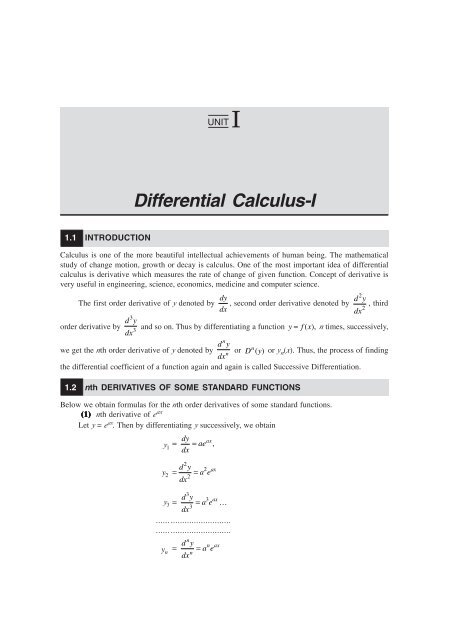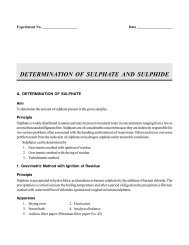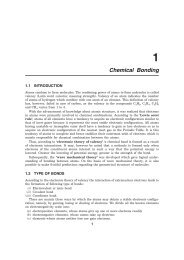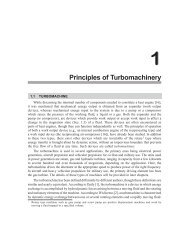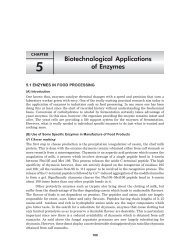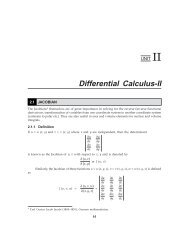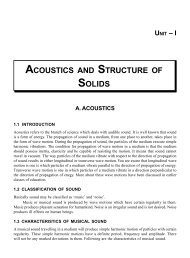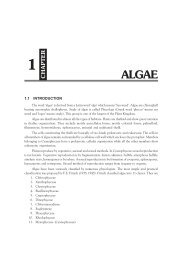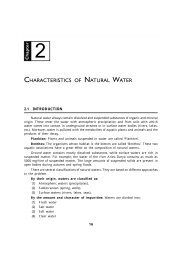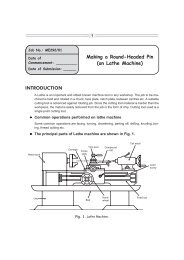Differential Calculus-I - New Age International
Differential Calculus-I - New Age International
Differential Calculus-I - New Age International
You also want an ePaper? Increase the reach of your titles
YUMPU automatically turns print PDFs into web optimized ePapers that Google loves.
1.1 INTRODUCTION<br />
UNIT I<br />
<strong>Differential</strong> <strong>Calculus</strong>-I<br />
<strong>Calculus</strong> is one of the more beautiful intellectual achievements of human being. The mathematical<br />
study of change motion, growth or decay is calculus. One of the most important idea of differential<br />
calculus is derivative which measures the rate of change of given function. Concept of derivative is<br />
very useful in engineering, science, economics, medicine and computer science.<br />
2<br />
dy d y<br />
The first order derivative of y denoted by , second order derivative denoted by , third<br />
dx<br />
2<br />
dx<br />
3<br />
d y<br />
order derivative by 3 and so on. Thus by differentiating a function y = f (x),<br />
n times, successively,<br />
dx<br />
n<br />
d y<br />
we get the nth order derivative of y denoted by n or D (y)<br />
dx<br />
n or yn (x). Thus, the process of finding<br />
the differential coefficient of a function again and again is called Successive Differentiation.<br />
1.2 nth DERIVATIVES OF SOME STANDARD FUNCTIONS<br />
Below we obtain formulas for the nth order derivatives of some standard functions.<br />
(1) (1) (1) nth derivative of eax Let y = eax . Then by differentiating y successively, we obtain<br />
dy ax<br />
y = = ae ,<br />
1 dx<br />
2<br />
d y 2<br />
y 2 = = ae<br />
2<br />
dx<br />
3<br />
ax<br />
dy 3 ax<br />
y3 = = ae …<br />
3<br />
dx<br />
................................<br />
................................<br />
yn<br />
n<br />
d y<br />
=<br />
= a<br />
n<br />
dx<br />
n<br />
e<br />
ax
2 A TEXTBOOK OF ENGINEERING MATHEMATICS–I<br />
Thus, we have the formula<br />
In particular,<br />
( )<br />
ax n D e<br />
( )<br />
x n D e<br />
n ax<br />
= a e<br />
...(1)<br />
x<br />
= e<br />
...(2)<br />
(2) (2) nth derivative of log (ax + b)<br />
Let y = log( ax + b).<br />
Then we find, by successive differentiation<br />
y 1<br />
dy a<br />
= =<br />
dx ax + b<br />
2<br />
2<br />
d y a<br />
y2 = = ( −1)<br />
2<br />
2<br />
dx<br />
( ax + b)<br />
3<br />
3<br />
d y<br />
a<br />
y3 = = ( −1)<br />
( −2)<br />
⋅<br />
3<br />
3<br />
dx<br />
( ax + b)<br />
4 4<br />
d y a<br />
y4 = = ( −1)( −2)( −3)<br />
4 4<br />
dx ( ax + b)<br />
... ............................................<br />
... ............................................<br />
yn<br />
Thus, we have the formula<br />
In particular,<br />
D n<br />
n<br />
d y<br />
= = ( −1)<br />
n<br />
dx<br />
n−1<br />
n−1n ( −1) ⋅( n−1)! a<br />
[log( ax + b)]<br />
=<br />
n<br />
( ax + b)<br />
D [logx]<br />
n<br />
(3) (3) nth derivative of (ax + b) m<br />
n−1<br />
( −1) ⋅( n −1)!<br />
=<br />
n<br />
x<br />
Let y m<br />
= ( ax + b)<br />
Differentiating successively, we get<br />
y1<br />
y2<br />
=<br />
dy<br />
= ma ( ax + b)<br />
dx<br />
2<br />
( n −1)!<br />
a<br />
⋅<br />
( ax + b)<br />
m−1<br />
d<br />
y<br />
2<br />
= = m(<br />
m −1)<br />
⋅ a ( ax + b)<br />
2<br />
dx<br />
n<br />
n<br />
m−2<br />
...(3)<br />
...(4)
DIFFERENTIAL CALCULUS-I 3<br />
3<br />
d y<br />
3 m−2<br />
y3<br />
= = m(<br />
m −1)<br />
( m − 2)<br />
a ( ax + b)<br />
3<br />
dx<br />
........................................................<br />
........................................................<br />
yn<br />
n m−n<br />
( m −1)<br />
( m − 2)<br />
L ( m − n + 1)<br />
a ( ax + b<br />
...(5)<br />
= m<br />
)<br />
This formula is true for all m.<br />
Following are some particular cases.<br />
Case Case ( (iiiii): ( ( ): Suppose m = n (a +ve integer)<br />
In equation (5) becomes,<br />
n<br />
n<br />
n n n<br />
D [( ax + b)<br />
] = nn ( 1) ( n 2) 1 a( ax b) −<br />
− − ⋯ ⋅ +<br />
n<br />
= n! a<br />
...(6)<br />
In particular,<br />
( )<br />
n n D x = n!<br />
...(7)<br />
Case Case (<br />
( (ii ii): ii ii ii ): Suppose m is a positive integer and m > n. Then formula (5) becomes<br />
n<br />
D [( ax + b)<br />
m<br />
]<br />
m( m−1) …( m− n+ 1)( m−n)( m−n−1) …2⋅1<br />
= ⋅ a ( ax+ b)<br />
( m−n)( m−n−1) …2⋅1<br />
m! n m − n<br />
= a ( ax + b)<br />
( m − n)<br />
!<br />
In particular,<br />
( )<br />
m n m! m − n<br />
D x = x<br />
( m − n)<br />
!<br />
Case Case ( (<br />
( (iii iii): iii iii iii ): Suppose m is a positive integer and n > m. From (6) we note that<br />
n m−n ...(8)<br />
...(9)<br />
n m<br />
D [( ax + b)<br />
] ! m<br />
= m a<br />
In differentiate further, the right-hand side gives zero.<br />
Thus, n m<br />
D [( ax + b)<br />
] = 0 if n > m ...(10)<br />
In particular,<br />
( )<br />
m n D x = 0 for n > m ...(11)<br />
Case Case ( (<br />
( (iv iv): iv iv iv ): Suppose m = – 1, in this case formula (5) becomes,<br />
n ⎡ 1 ⎤<br />
n<br />
D ⎢ax + b⎥<br />
= ( −1)<br />
( −2)<br />
( −3)<br />
K(<br />
−n)<br />
a ( ax + b)<br />
⎣ ⎦<br />
n n<br />
( 1) n! a<br />
( ax b )<br />
+<br />
− ⋅<br />
=<br />
+<br />
n 1<br />
−1−n<br />
...(12)
4 A TEXTBOOK OF ENGINEERING MATHEMATICS–I<br />
Case Case ( (vvvvv): ( ): Suppose m is a negative integer. Let us get m = – p, so that p is a positive integer. Then<br />
formula (5) becomes,<br />
⎡ ⎤<br />
⎢ ⎥<br />
⎣ + ⎦<br />
P<br />
n 1 ( 1) pp ( 1) ( p n 1) a<br />
D<br />
p n<br />
( ax b)<br />
( ax b )<br />
+<br />
− ⋅ + … + − ⋅<br />
=<br />
+<br />
n n<br />
n 12 p 1 p( p 1) ( p n 1) a<br />
( 1)<br />
12 p 1 p n<br />
( ax b )<br />
+<br />
⋅ … − + … + −<br />
= − ⋅ ⋅<br />
⋅ … − +<br />
n n<br />
( 1) ( p n 1)! a<br />
( p 1)! ( ax b )<br />
+<br />
− ⋅ + −<br />
= ⋅<br />
− +<br />
In particular<br />
n ⎛ 1 ⎞ n ( p n 1)! 1<br />
D ⎜ p ⎟ ( 1)<br />
⎝ x ⎠ ( p 1)! p n<br />
x +<br />
+ −<br />
= − ⋅ ⋅<br />
−<br />
(4) (4) nth derivative of cos (ax + b)<br />
Let y = cos( ax + b).<br />
Differentiating this successively, we get<br />
y<br />
y<br />
p n<br />
dy<br />
y1<br />
= =− asin( ax + b) = acos( ax + b+π/<br />
2)<br />
dx<br />
2<br />
dy<br />
=<br />
dx<br />
2 2<br />
3<br />
dy<br />
=<br />
dx<br />
3 3<br />
2<br />
=− a sin( ax+ b+π/<br />
2)<br />
2<br />
= a cos( ax + b + 2π<br />
/ 2)<br />
3<br />
=− a sin( ax+ b+<br />
2 π/<br />
2)<br />
3<br />
= a cos( ax+ b+<br />
3 π/<br />
2)<br />
..... ................................<br />
..... ................................<br />
n<br />
d y n<br />
y n = = a cos( ax+ b+ nπ/2)<br />
n<br />
dx<br />
Thus, we obtain the formula<br />
n<br />
...(13)<br />
...(14)<br />
D [cos( ax b)]<br />
n<br />
+ = a cos( ax + b + nπ<br />
/ 2)<br />
n In particular,<br />
...(15)<br />
D (cosx)<br />
n = cos( x + nπ/<br />
2)<br />
...(16)<br />
(5) (5) nth derivative of sin(ax + b)<br />
Let y =<br />
sin( ax + b)
DIFFERENTIAL CALCULUS-I 5<br />
Differentiating successively, we get<br />
d<br />
dy<br />
dx<br />
2<br />
dx<br />
dx<br />
Thus, we have the formula,<br />
y<br />
2<br />
= y = a cos( ax + b)<br />
= asin(<br />
ax + b + π / 2)<br />
1<br />
2<br />
= y = a cos( ax + b + π / 2)<br />
= a sin( ax + b + 2π<br />
/ 2)<br />
2<br />
3<br />
d y<br />
3<br />
3 3<br />
= y3 = a cos( ax + b + 2 π /2) = a sin( ax + b + 3 π/2)<br />
dx<br />
............................................................................<br />
............................................................................<br />
d<br />
n<br />
y<br />
n<br />
n<br />
= y = a sin( ax + b + nπ<br />
/ 2)<br />
n<br />
D [sin( ax b)]<br />
n<br />
n + = a sin( ax+ b+ nπ<br />
/2)<br />
In particular,<br />
...(17)<br />
D (sinx)<br />
n = sin( x + nπ<br />
/ 2)<br />
...(18)<br />
(6) (6) nth derivative of eax sin (bx + c)<br />
Let y = sin( bx + c)<br />
e ax<br />
dy ax<br />
ax<br />
y 1 = = ae sin( bx + c)<br />
+ be cos( bx + c)<br />
dx<br />
For computation of higher-order derivatives it is convenient to express the constants a and b in<br />
terms of the constants k and a defined by<br />
a = k cosα, b = ksinα<br />
So that<br />
Thus,<br />
Therefore,<br />
2 2 −1<br />
k= a + b , α= tan ( b/ a)<br />
dy ax<br />
y 1 = = e [ k(cos α )sin( bx + c) + k(sin α )cos( bx + c)]<br />
dx<br />
2<br />
ax<br />
= ke sin( bx + c +α)<br />
d y<br />
y ax ax<br />
2 = = k[ ae sin( bx + c +α ) + be cos( bx + c +α)]<br />
2<br />
dx<br />
ax<br />
= ke [ k(cos α )sin( bx+ c+α ) + k(sin α ) cos( bx+ c+α)]<br />
2 ax<br />
= k e sin( bx + c + 2α)<br />
2
6 A TEXTBOOK OF ENGINEERING MATHEMATICS–I<br />
Proceeding like this, we obtain<br />
dx<br />
Thus, we have the formula<br />
D ax n<br />
n<br />
d y<br />
y n = n ax<br />
n = k e sin( bx + c + nα)<br />
2 2 n /2 −1<br />
= ( a + b ) sin{ bx+ c+ ntan ( ba / )}<br />
...(19)<br />
[ e sin( bx + c)]<br />
In particular,<br />
n x<br />
D [ e sin x ] 2 sin( / 4)<br />
2 /<br />
= ⋅ e x + nπ<br />
x n ...(20)<br />
(7) (7) nth derivative of eax cos(bx + c)<br />
Let y = cos( bx + c)<br />
Then<br />
Therefore,<br />
dy<br />
y 1 =<br />
dx<br />
2<br />
e ax<br />
= ae<br />
ax<br />
ax<br />
ax<br />
cos( bx + c)<br />
− be sin( bx + c)<br />
= e [ k(cos α )cos( bx + c) −k(sin α )sin( bx + c)]<br />
= cos( bx + c + α)<br />
ke ax<br />
d y<br />
y 2 = ax<br />
ax<br />
= k[<br />
ae cos( bx + c + α)<br />
− be sin( bx + c + α)]<br />
2<br />
dx<br />
= k e cos( bx + c + 2α)<br />
Proceeding like this, we obtain<br />
n<br />
d y<br />
y n = n ax<br />
= k e cos( bx + c + nα)<br />
n<br />
dx<br />
Thus, we have the formula<br />
n ax<br />
D [ e cos( bx+ c)]<br />
In particular,<br />
ax<br />
= ke [ k(cos α ) cos( bx+ c+α) −k(sin α )sin( bx+ c+α)]<br />
2<br />
ax<br />
D x n n/2 x<br />
2 2 n/2 ax<br />
−1<br />
= ( a + b ) e cos{ bx+ c+ ntan ( ba / )}<br />
...(21)<br />
( e cosx)<br />
= 2 e cos( x+ nπ<br />
/4)<br />
...(22)<br />
(8) (8) nth derivative of amx Let y mx<br />
= a<br />
Taking logarithm on both sides,<br />
logy = mx loga<br />
Differentiating w.r.t. ‘x’, we get<br />
1 dy<br />
⋅ = m<br />
loga ⋅1<br />
y dx
DIFFERENTIAL CALCULUS-I 7<br />
dy<br />
y 1 =<br />
dx<br />
2<br />
= ( m loga)<br />
⋅ y<br />
d y<br />
y 2 = = m loga ⋅ y<br />
2<br />
1<br />
dx<br />
= ( m loga)(<br />
m loga)<br />
⋅ y<br />
3<br />
= ( mloga)<br />
d y<br />
2<br />
y 3 = = ( mlog a) ⋅y<br />
3<br />
dx<br />
= ( mloga)<br />
2<br />
3<br />
y<br />
y<br />
........................<br />
........................<br />
n<br />
d y<br />
y n = n<br />
m a y<br />
n = ( log ) ⋅<br />
dx<br />
n mx<br />
[ ]<br />
D a = ( mlog a) ⋅a<br />
1<br />
n mx<br />
WORKED EXAMPLES<br />
Example Example 1: 1: Find the nth derivative of the following functions:<br />
Solution:<br />
Solution:<br />
(i) 3<br />
y = sin x<br />
(i) sin 3 x (ii) cos 4 x.<br />
where 3<br />
x<br />
\ (sin )<br />
3 D x<br />
n<br />
(ii) y = cos 4 x<br />
where 2<br />
x<br />
so that 4<br />
cos x<br />
1<br />
sin = ( 3sin<br />
x − sin3x)<br />
4<br />
3 n 1 n<br />
= D (sinx)<br />
− D (sin3x)<br />
4 4<br />
=<br />
3 ⎛ nπ<br />
⎞ 3 ⎛ nπ<br />
⎞<br />
sin⎜<br />
x + ⎟ − sin⎜3x<br />
+ ⎟<br />
4 ⎝ 2 ⎠ 4 ⎝ 2 ⎠<br />
1<br />
cos = ( 1 + cos2x)<br />
2<br />
1<br />
= ( 1+<br />
cos2x)<br />
4<br />
1 2<br />
=<br />
[ 1+<br />
cos 2x<br />
+ 2cos2x]<br />
4<br />
2<br />
n<br />
[Using the formula (15)]
8 A TEXTBOOK OF ENGINEERING MATHEMATICS–I<br />
where cos 2x<br />
2<br />
\ 4<br />
x<br />
\<br />
1<br />
= ( 1 + cos4x)<br />
2<br />
1 ⎡ 1<br />
⎤<br />
cos = ⎢1<br />
+ ( 1+<br />
cos4x)<br />
+ 2 cos2x<br />
4<br />
⎥<br />
⎣ 2<br />
⎦<br />
=<br />
1<br />
4<br />
+<br />
1<br />
8<br />
1 1<br />
+ cos4x<br />
+ cos2x<br />
8 2<br />
4 3 1 1<br />
cos x = + cos2x<br />
+ cos4x<br />
8 2 8<br />
n 4 n ⎛ 3⎞<br />
1 n 1 n<br />
D (cos x ) = D ⎜ ⎟ + D (cos2x)<br />
+ D (cos4x)<br />
⎝ 8 ⎠ 2<br />
8<br />
n n<br />
2 ⎛ nπ⎞ 4 ⎛ nπ⎞<br />
= 0 + cos 2x cos 4x<br />
2<br />
⎜ +<br />
2<br />
⎟+ +<br />
8<br />
⎜<br />
2<br />
⎟<br />
⎝ ⎠ ⎝ ⎠<br />
n n<br />
2 ⎛ nπ⎞ 4 ⎛ nπ⎞<br />
= cos 2x cos 4x<br />
2<br />
⎜ +<br />
2<br />
⎟+ +<br />
8<br />
⎜<br />
2<br />
⎟<br />
⎝ ⎠ ⎝ ⎠<br />
Example Example 2: 2: Find the nth derivative of the following:<br />
(i) sin h 2x<br />
sin4x<br />
(ii)<br />
−x<br />
2<br />
e sin x<br />
(iii) e x<br />
(v)<br />
Solution:<br />
Solution:<br />
x<br />
(i)<br />
1 2x<br />
−2x<br />
sinh<br />
2x<br />
sin4x<br />
= ( e − e ) ⋅ sin4x<br />
2<br />
sin h2x x 3 2 cos (iv) e x x<br />
x<br />
e x<br />
−<br />
sin cos 2<br />
ax<br />
cos sin<br />
2<br />
1 2x<br />
−2x<br />
sin h2x sin4x<br />
= [ e sin4x<br />
− e sin4x]<br />
2<br />
n 1 n 2x n −2x<br />
D (sinh 2x<br />
sin4x)<br />
= [ D ( e sin4 x) −D<br />
( e sin4 x)]<br />
2<br />
2x −<br />
−2x<br />
e e<br />
=<br />
2<br />
1 n/2 2x −1−2x −1<br />
[20 { e sin(4x ntan2) e sin(4x ntan2)}]<br />
=<br />
2<br />
+ − −<br />
Using the formula (19)
DIFFERENTIAL CALCULUS-I 9<br />
1<br />
(ii) We have sin ( 1 cos2<br />
)<br />
2<br />
2<br />
x = − x<br />
Therefore,<br />
n −x 2 1 n −x 1 n −x<br />
x = −<br />
D ( e<br />
sin<br />
1<br />
(iii) We have cos (cos3<br />
3cos<br />
)<br />
4<br />
3<br />
x = x + x<br />
n<br />
D ( e<br />
2x<br />
3<br />
)<br />
D ( e ) D ( e cos2 x)<br />
2 2<br />
1 −x n 1 n/2 −x −1<br />
= e ( −1) − [5 e cos(2x+ ntan<br />
( −2))]<br />
2 2<br />
1 −x n n/2<br />
−1<br />
= e [( −1) −5cos(2x−ntan (2))]<br />
2<br />
cos x)<br />
= D ( e<br />
4<br />
1 n 2x<br />
2x<br />
3 n<br />
cos3x)<br />
+ D ( e<br />
4<br />
cosx)<br />
1 2 2 n/2 2x −1<br />
[(2 3 ) e cos{3x ntan<br />
(3/ 2)}]<br />
= + +<br />
4<br />
3 2 2 / 2 2<br />
−1<br />
e x n<br />
+ [( 2 + 1 ) cos{ x + n tan<br />
4<br />
1 2x n / 2<br />
−1<br />
= e [ 13 cos{ 3x<br />
+ n tan<br />
4<br />
n / 2<br />
−1<br />
+ 3(<br />
5)<br />
⋅ cos{ x + n tan<br />
1<br />
(iv) We have sin x cos2x<br />
= (sin3x<br />
− sin x)<br />
2<br />
Therefore,<br />
n −x<br />
1<br />
D ( e sin x cos2x)<br />
= D ( e<br />
2<br />
(v) We note that<br />
= [(( −1)<br />
2<br />
1 n<br />
sin3x)<br />
− D ( e<br />
2<br />
n −x<br />
−x<br />
+ 3<br />
)<br />
( 3/<br />
2)}<br />
( 1/<br />
2)}]<br />
sin x)<br />
1 2 2 / 2 −<br />
−1<br />
e x n<br />
− [(( −1)<br />
2<br />
= e<br />
2<br />
sin{ 3x<br />
+ n tan<br />
1 2 2 / 2 −<br />
−1<br />
+ 1 ) e sin{ x + n tan<br />
x n<br />
1 −x<br />
n / 2<br />
−1<br />
n / 2<br />
[ 10<br />
sin( 3x<br />
− ntan<br />
2 1<br />
cos xsinx =<br />
( 1 + cos2x)<br />
⋅ sin x<br />
2<br />
3)<br />
− 2<br />
( 1/<br />
2)}]<br />
( −3)}]<br />
( −1)}]<br />
sin( x − nπ<br />
/ 4)]
10 A TEXTBOOK OF ENGINEERING MATHEMATICS–I<br />
\ 2<br />
D ( e cos xsin<br />
x)<br />
ax n<br />
=<br />
1 1<br />
= sin x + ⋅ 2sin<br />
x cos2x<br />
2 4<br />
1 1<br />
= sin x + (sin3x<br />
− sin x)<br />
2 4<br />
1 1<br />
= sin x + sin3x<br />
4 4<br />
1<br />
4<br />
n<br />
ax<br />
D ( e<br />
1 n<br />
sinx)<br />
+ D ( e<br />
4<br />
ax<br />
sin3x)<br />
1 ax 2 n /2 −1<br />
= e [( a + 1) sin{ x+ ntan (1/ a)}<br />
4<br />
n / 2<br />
−1<br />
+ ( a + 9)<br />
sin{ 3x<br />
+ n tan ( 3/<br />
a)}]<br />
Example Example 3: 3: 3: Find the nth derivative of the following:<br />
(i)<br />
Solution:<br />
Solution:<br />
x + 3<br />
( x −1)(<br />
x + 2)<br />
(i)<br />
x + 3<br />
y =<br />
( x −1)(<br />
x + 2)<br />
By partial fractions<br />
2<br />
(ii)<br />
x + 3<br />
( x −1)(<br />
x + 2)<br />
A B<br />
= +<br />
x − 1 x + 2<br />
Then x + 3 = Ax ( + 2) + Bx ( −1)<br />
Taking x = 1 ⇒ A = 4/3<br />
Equation (1), becomes<br />
x =−2 ⇒ B =−1/3<br />
x + 3 4 1 1 1<br />
= ⋅ −<br />
( x −1)(<br />
x + 2)<br />
3 ( x− 1) 3( x+<br />
2)<br />
2<br />
x<br />
( x + 2)(<br />
2x<br />
+ 3)<br />
⎡ x + 3 ⎤<br />
D ⎢<br />
⎥<br />
⎣(<br />
x −1)(<br />
x + 2)<br />
⎦<br />
n 4 n⎛ 1 ⎞ 1 n⎛<br />
1 ⎞<br />
= D D<br />
3<br />
⎜ −<br />
x− 1<br />
⎟<br />
3<br />
⎜<br />
x+<br />
2<br />
⎟<br />
⎝ ⎠ ⎝ ⎠<br />
n n<br />
4( −1) ⋅n! 1( −1) ⋅n!<br />
= −<br />
3 ( x − 1) 3(<br />
x + 2)<br />
n+ 1 n+<br />
1<br />
1 n ⎡ 4 1 ⎤<br />
= ( −1) ⋅n! ⎢ −<br />
3 n+ 1 n+<br />
1⎥<br />
⎣( x− 1) ( x+<br />
2) ⎦<br />
...(1)<br />
[Using the formula (12)]


